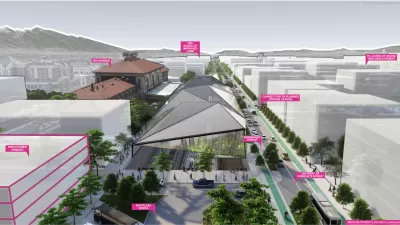According to Yonah Freemark, there's folly in the way the federal government has been funding rail transit projects but failing to set standards for minimum service—a key indicator of transit ridership success.
Yonah Freemark introduces a discussion of transit service standards by citing the example of Salt Lake City's S-Line rail transit project. The project was built at costs competitive with bus rapid transit but has delivered only a third of the projected ridership.
According to Freemark, "providing new rail lines isn’t enough – service standards really matter when it comes to attracting people to use transit. And on that front, too many transit agencies around the country are failing to offer the services people can rely on."
Freemark goes on to point out that, while the Federal government has been funding the majority of recent streetcar and light rail projects, they've also failed "to enforce any sort of minimum level of service." More specifically, "[rather] than mandate that new services funded through grants offer service at least every 15 minutes, for example, the Federal Transit Administration simply requires agencies to 'develop quantitative standards for all fixed route modes of operation' for issues like vehicle headway. In other words, if a transit agency provides service every three hours on a just-built rail line, that’s fine — as long as that information has been submitted in triplicate to Washington in advance."
FULL STORY: A Call for Minimum Service Standards

Maui's Vacation Rental Debate Turns Ugly
Verbal attacks, misinformation campaigns and fistfights plague a high-stakes debate to convert thousands of vacation rentals into long-term housing.

Planetizen Federal Action Tracker
A weekly monitor of how Trump’s orders and actions are impacting planners and planning in America.

San Francisco Suspends Traffic Calming Amidst Record Deaths
Citing “a challenging fiscal landscape,” the city will cease the program on the heels of 42 traffic deaths, including 24 pedestrians.

Half of Post-Fire Altadena Home Sales Were to Corporations
Large investors are quietly buying up dozens of properties in Altadena, California, where a devastating wildfire destroyed more than 6,000 homes in January.

Opinion: What San Francisco’s Proposed ‘Family Zoning’ Could Really Mean
Mayor Lurie is using ‘family zoning’ to encourage denser development and upzoning — but could the concept actually foster community and more human-scale public spaces?

Jacksonville Launches First Autonomous Transit Shuttle in US
A fleet of 14 fully autonomous vehicles will serve a 3.5-mile downtown Jacksonville route with 12 stops.
Urban Design for Planners 1: Software Tools
This six-course series explores essential urban design concepts using open source software and equips planners with the tools they need to participate fully in the urban design process.
Planning for Universal Design
Learn the tools for implementing Universal Design in planning regulations.
Gallatin County Department of Planning & Community Development
Heyer Gruel & Associates PA
JM Goldson LLC
City of Camden Redevelopment Agency
City of Astoria
Transportation Research & Education Center (TREC) at Portland State University
Jefferson Parish Government
Camden Redevelopment Agency
City of Claremont





























